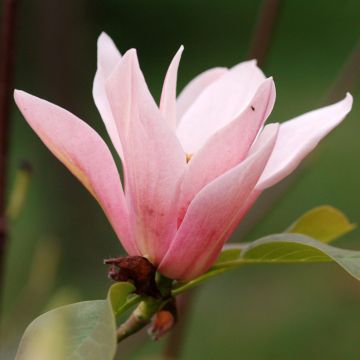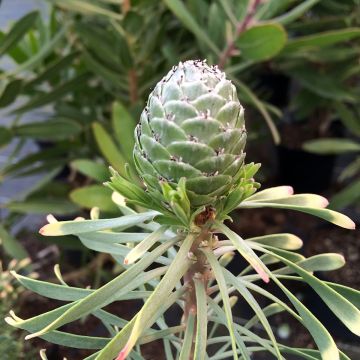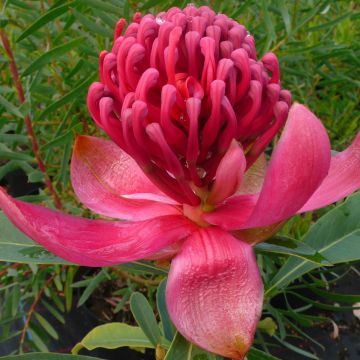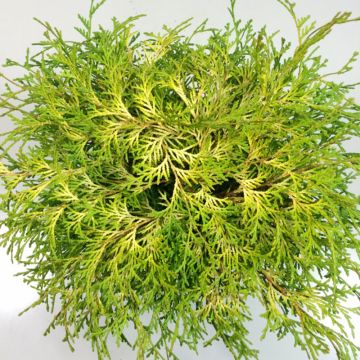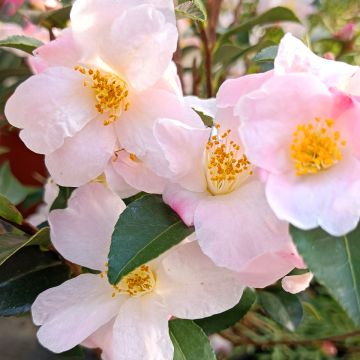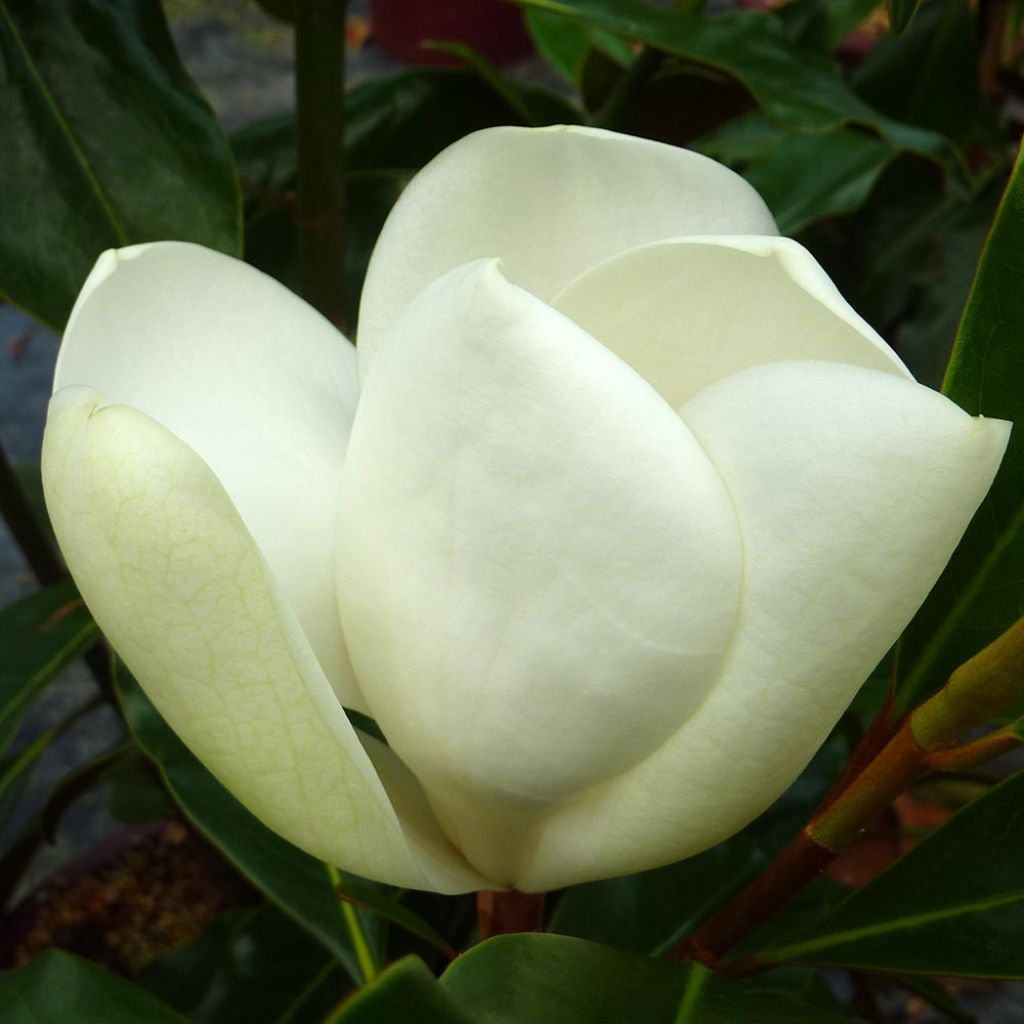

Magnolia grandiflora Kay Parris


Magnolia grandiflora Kay Parris
Magnolia grandiflora Kay Parris
Magnolia grandiflora Kay Parris
Summer Magnolia, Large-flowered Magnolia, Bull bay Magnolia, Evergreen Magnolia
Order arrived quickly (autumn), magnolia that matches the description and seems to be thriving where I placed it after a few days of planting.
Muriel, 21/10/2024
This item cannot be shipped to the selected country
Delivery charge from €5.90
Delivery to Corse prohibited
More information
Schedule delivery date,
and select date in basket
This plant carries a 24 months recovery warranty
More information
We guarantee the quality of our plants for a full growing cycle, and will replace at our expense any plant that fails to recover under normal climatic and planting conditions.
From €5.90 for pickup delivery and €6.90 for home delivery
Express home delivery from €8.90.
Delivery to Corse prohibited: UE law prohibits the import of this plant from mainland France to Corse as part of the fight against Xylella fastidiosa. Please accept our sincere apologies.
More information

Does this plant fit my garden?
Set up your Plantfit profile →
Description
The Magnolia grandiflora 'Kay Parris' allows this majestic evergreen tree, which is a bit sensitive to cold, known as the Large-flowered Magnolia, to enter smaller gardens. With moderate growth and a narrow and regular habit, this variety has beautiful foliage with a velvety brown-red color and has the same summer flowering that is appreciated for its fragrance and beauty. For almost three months, even on a young specimen, flowers similar to beautiful white tulips with a deliciously lemon scent bloom. 'Kay Parris' works wonders as a solitary plant in the garden, but also in a large container on the terrace.
Originally from the Southeastern United States, the Magnolia grandiflora loves light, heat, humidity, and rich, deep soil. Its range extends from Texas to Virginia, passing through the north and center of Florida.
'Kay Parris' is a recent cultivar selected for its reduced growth and cold resistance, down to -15°C (5°F) at its peak. Ultimately, it will rarely exceed 4m (13ft) in height, with a spread of 2m. Its slow growth allows it to be cultivated for several years in a large container, where it will maintain a more modest size. The flowering mainly takes place in summer, from June to August-September (in the southeastern USA, flowering begins in late April and ends in July). The large solitary flowers, shaped like 12 to 13cm (5in) diameter tulips, are composed of thick petals, pure white, open around a cone covered with yellow stamens. Each flower only lives for one day on the tree, but they continuously appear here and there on the branches, standing out well from the foliage. This flowering is followed by the formation of large reddish cones, quite decorative, revealing red seeds. The simple, entire, leathery leaves, 15 to 20cm (6 to 8in) long, are dark green and shiny on the upper side, but covered with a velvety brown-red on the underside. They persist through winter.
The Magnolia grandiflora 'Kay Parris' will obviously find its place as a solitary plant in the garden, but also in a large container on the terrace. Choose a strategic location to be able to admire this charming small tree, perhaps the most beautiful of all evergreens, and enjoy its intensely lemon-scented flowering. It could be combined, for example, with another small, deciduous magnolia with spring flowering, such as the Magnolia 'George Henry Kern'. This magnolia lends itself well to topiary art and can be shaped into a pyramid, to be placed, for example, on either side of a gate or a large stone porch.
Report an error about the product description
Magnolia grandiflora Kay Parris in pictures
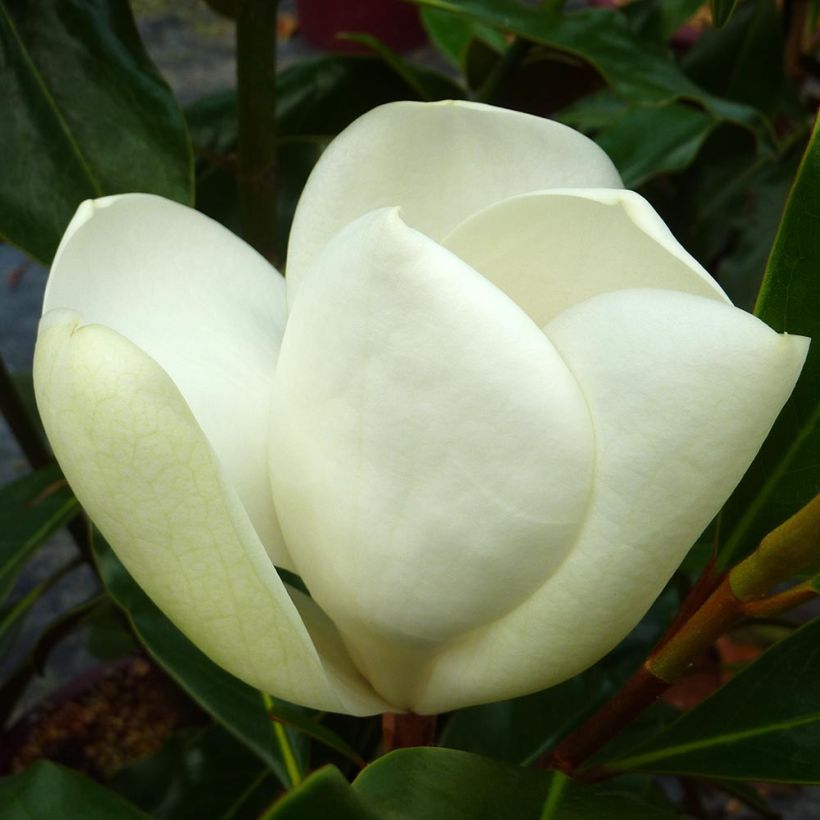

Plant habit
Flowering
Foliage
Botanical data
Magnolia
grandiflora
Kay Parris
Magnoliaceae
Summer Magnolia, Large-flowered Magnolia, Bull bay Magnolia, Evergreen Magnolia
Cultivar or hybrid
Other Magnolia
Planting and care
Magnolia grandiflora 'Kay Parris' should be planted in the spring in deep, rich, moist, firm soil, in a good forest soil (pH 6) enriched with clay garden soil. Pure ericaceous compost is not recommended as it is too nutrient-poor. Avoid lime-containing soils. It prefers a sunny and open exposure, sheltered from dominant winds. It is advisable to protect young plants from heavy frosts during the first two or three years: cover them with a thick winter veil in case of any expected heavy frosts, then remove it as soon as the temperatures soften a bit. The weight of the snow weakens the branches, which can break. Be careful not to break the fleshy roots and not to bury the root ball too deeply. Mulch and water in summer. Pay attention to hot and dry summers, this magnolia requires the soil to remain fairly moist in summer. Maintain good moisture by showering its foliage with a fine spray, only in the evening. Pruning is unnecessary. If desired, it should be done sparingly just after flowering.
Planting period
Intended location
Care
-
, onOrder confirmed
Reply from on Promesse de fleurs
Evergreen shrubs
Haven't found what you were looking for?
Hardiness is the lowest winter temperature a plant can endure without suffering serious damage or even dying. However, hardiness is affected by location (a sheltered area, such as a patio), protection (winter cover) and soil type (hardiness is improved by well-drained soil).

Photo Sharing Terms & Conditions
In order to encourage gardeners to interact and share their experiences, Promesse de fleurs offers various media enabling content to be uploaded onto its Site - in particular via the ‘Photo sharing’ module.
The User agrees to refrain from:
- Posting any content that is illegal, prejudicial, insulting, racist, inciteful to hatred, revisionist, contrary to public decency, that infringes on privacy or on the privacy rights of third parties, in particular the publicity rights of persons and goods, intellectual property rights, or the right to privacy.
- Submitting content on behalf of a third party;
- Impersonate the identity of a third party and/or publish any personal information about a third party;
In general, the User undertakes to refrain from any unethical behaviour.
All Content (in particular text, comments, files, images, photos, videos, creative works, etc.), which may be subject to property or intellectual property rights, image or other private rights, shall remain the property of the User, subject to the limited rights granted by the terms of the licence granted by Promesse de fleurs as stated below. Users are at liberty to publish or not to publish such Content on the Site, notably via the ‘Photo Sharing’ facility, and accept that this Content shall be made public and freely accessible, notably on the Internet.
Users further acknowledge, undertake to have ,and guarantee that they hold all necessary rights and permissions to publish such material on the Site, in particular with regard to the legislation in force pertaining to any privacy, property, intellectual property, image, or contractual rights, or rights of any other nature. By publishing such Content on the Site, Users acknowledge accepting full liability as publishers of the Content within the meaning of the law, and grant Promesse de fleurs, free of charge, an inclusive, worldwide licence for the said Content for the entire duration of its publication, including all reproduction, representation, up/downloading, displaying, performing, transmission, and storage rights.
Users also grant permission for their name to be linked to the Content and accept that this link may not always be made available.
By engaging in posting material, Users consent to their Content becoming automatically accessible on the Internet, in particular on other sites and/or blogs and/or web pages of the Promesse de fleurs site, including in particular social pages and the Promesse de fleurs catalogue.
Users may secure the removal of entrusted content free of charge by issuing a simple request via our contact form.
The flowering period indicated on our website applies to countries and regions located in USDA zone 8 (France, the United Kingdom, Ireland, the Netherlands, etc.)
It will vary according to where you live:
- In zones 9 to 10 (Italy, Spain, Greece, etc.), flowering will occur about 2 to 4 weeks earlier.
- In zones 6 to 7 (Germany, Poland, Slovenia, and lower mountainous regions), flowering will be delayed by 2 to 3 weeks.
- In zone 5 (Central Europe, Scandinavia), blooming will be delayed by 3 to 5 weeks.
In temperate climates, pruning of spring-flowering shrubs (forsythia, spireas, etc.) should be done just after flowering.
Pruning of summer-flowering shrubs (Indian Lilac, Perovskia, etc.) can be done in winter or spring.
In cold regions as well as with frost-sensitive plants, avoid pruning too early when severe frosts may still occur.
The planting period indicated on our website applies to countries and regions located in USDA zone 8 (France, United Kingdom, Ireland, Netherlands).
It will vary according to where you live:
- In Mediterranean zones (Marseille, Madrid, Milan, etc.), autumn and winter are the best planting periods.
- In continental zones (Strasbourg, Munich, Vienna, etc.), delay planting by 2 to 3 weeks in spring and bring it forward by 2 to 4 weeks in autumn.
- In mountainous regions (the Alps, Pyrenees, Carpathians, etc.), it is best to plant in late spring (May-June) or late summer (August-September).
The harvesting period indicated on our website applies to countries and regions in USDA zone 8 (France, England, Ireland, the Netherlands).
In colder areas (Scandinavia, Poland, Austria...) fruit and vegetable harvests are likely to be delayed by 3-4 weeks.
In warmer areas (Italy, Spain, Greece, etc.), harvesting will probably take place earlier, depending on weather conditions.
The sowing periods indicated on our website apply to countries and regions within USDA Zone 8 (France, UK, Ireland, Netherlands).
In colder areas (Scandinavia, Poland, Austria...), delay any outdoor sowing by 3-4 weeks, or sow under glass.
In warmer climes (Italy, Spain, Greece, etc.), bring outdoor sowing forward by a few weeks.



































